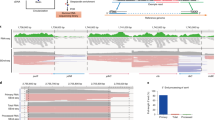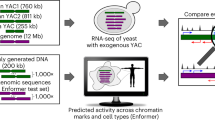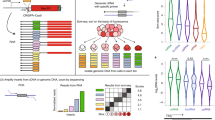Abstract
Pervasive and hidden transcription is widespread in eukaryotes1,2,3,4, but its global level, the mechanisms from which it originates and its functional significance are unclear. Cryptic unstable transcripts (CUTs) were recently described as a principal class of RNA polymerase II transcripts in Saccharomyces cerevisiae5. These transcripts are targeted for degradation immediately after synthesis by the action of the Nrd1–exosome–TRAMP complexes6,7. Although CUT degradation mechanisms have been analysed in detail, the genome-wide distribution at the nucleotide resolution and the prevalence of CUTs are unknown. Here we report the first high-resolution genomic map of CUTs in yeast, revealing a class of potentially functional CUTs and the intrinsic bidirectional nature of eukaryotic promoters. An RNA fraction highly enriched in CUTs was analysed by a 3′ Long-SAGE (serial analysis of gene expression) approach adapted to deep sequencing. The resulting detailed genomic map of CUTs revealed that they derive from extremely widespread and very well defined transcription units and do not result from unspecific transcriptional noise. Moreover, the transcription of CUTs predominantly arises within nucleosome-free regions, most of which correspond to promoter regions of bona fide genes. Some of the CUTs start upstream from messenger RNAs and overlap their 5′ end. Our study of glycolysis genes, as well as recent results from the literature8,9,10,11, indicate that such concurrent transcription is potentially associated with regulatory mechanisms. Our data reveal numerous new CUTs with such a potential regulatory role. However, most of the identified CUTs corresponded to transcripts divergent from the promoter regions of genes, indicating that they represent by-products of divergent transcription occurring at many and possibly most promoters. Eukaryotic promoter regions are thus intrinsically bidirectional, a fundamental property that escaped previous analyses because in most cases divergent transcription generates short-lived unstable transcripts present at very low steady-state levels.
This is a preview of subscription content, access via your institution
Access options
Subscribe to this journal
Receive 51 print issues and online access
$199.00 per year
only $3.90 per issue
Buy this article
- Purchase on Springer Link
- Instant access to full article PDF
Prices may be subject to local taxes which are calculated during checkout



Similar content being viewed by others
Accession codes
Primary accessions
ArrayExpress
Data deposits
Raw data are available from ArrayExpress (http://www.ebi.ac.uk/arrayexpress) under accession number E-MTAB-75 for SAGE data and E-TABM-602 for tiling array data.
References
Davis, C. A. & Ares, M. Accumulation of unstable promoter-associated transcripts upon loss of the nuclear exosome subunit Rrp6p in Saccharomyces cerevisiae . Proc. Natl Acad. Sci. USA 103, 3262–3267 (2006)
Johnson, J. M., Edwards, S., Shoemaker, D. & Schadt, E. E. Dark matter in the genome: evidence of widespread transcription detected by microarray tiling experiments. Trends Genet. 21, 93–102 (2005)
Kapranov, P. et al. Large-scale transcriptional activity in chromosomes 21 and 22. Science 296, 916–919 (2002)
Kapranov, P. et al. RNA maps reveal new RNA classes and a possible function for pervasive transcription. Science 316, 1484–1488 (2007)
Wyers, F. et al. Cryptic pol II transcripts are degraded by a nuclear quality control pathway involving a new poly(A) polymerase. Cell 121, 725–737 (2005)
Arigo, J. T., Eyler, D. E., Carroll, K. L. & Corden, J. L. Termination of cryptic unstable transcripts is directed by yeast RNA-binding proteins Nrd1 and Nab3. Mol. Cell 23, 841–851 (2006)
Thiebaut, M., Kisseleva-Romanova, E., Rougemaille, M., Boulay, J. & Libri, D. Transcription termination and nuclear degradation of cryptic unstable transcripts: a role for the Nrd1–Nab3 pathway in genome surveillance. Mol. Cell 23, 853–864 (2006)
Kuehner, J. N. & Brow, D. A. Regulation of a eukaryotic gene by GTP-dependent start site selection and transcription attenuation. Mol. Cell 31, 201–211 (2008)
Martens, J. A., Laprade, L. & Winston, F. Intergenic transcription is required to repress the Saccharomyces cerevisiae SER3 gene. Nature 429, 571–574 (2004)
Martens, J. A., Wu, P. Y. & Winston, F. Regulation of an intergenic transcript controls adjacent gene transcription in Saccharomyces cerevisiae . Genes Dev. 19, 2695–2704 (2005)
Thiebaut, M. et al. Futile cycle of transcription initiation and termination modulates the response to nucleotide shortage in S. cerevisiae . Mol. Cell 31, 671–682 (2008)
Rigaut, G. et al. A generic protein purification method for protein complex characterization and proteome exploration. Nature Biotechnol. 17, 1030–1032 (1999)
Wei, C. L. et al. 5′ Long serial analysis of gene expression (LongSAGE) and 3′ LongSAGE for transcriptome characterization and genome annotation. Proc. Natl Acad. Sci. USA 101, 11701–11706 (2004)
van Hoof, A., Lennertz, P. & Parker, R. Yeast exosome mutants accumulate 3′-extended polyadenylated forms of U4 small nuclear RNA and small nucleolar RNAs. Mol. Cell. Biol. 20, 441–452 (2000)
Bousquet-Antonelli, C., Presutti, C. & Tollervey, D. Identification of a regulated pathway for nuclear pre-mRNA turnover. Cell 102, 765–775 (2000)
David, L. et al. A high-resolution map of transcription in the yeast genome. Proc. Natl Acad. Sci. USA 103, 5320–5325 (2006)
Arigo, J. T., Carroll, K. L., Ames, J. M. & Corden, J. L. Regulation of yeast NRD1 expression by premature transcription termination. Mol. Cell 21, 641–651 (2006)
Scott, E. W. & Baker, H. V. Concerted action of the transcriptional activators REB1, RAP1, and GCR1 in the high-level expression of the glycolytic gene TPI . Mol. Cell. Biol. 13, 543–550 (1993)
Camblong, J., Iglesias, N., Fickentscher, C., Dieppois, G. & Stutz, F. Antisense RNA stabilization induces transcriptional gene silencing via histone deacetylation in S. cerevisiae . Cell 131, 706–717 (2007)
Teodorovic, S., Walls, C. D. & Elmendorf, H. G. Bidirectional transcription is an inherent feature of Giardia lamblia promoters and contributes to an abundance of sterile antisense transcripts throughout the genome. Nucleic Acids Res. 35, 2544–2553 (2007)
Lee, W. et al. A high-resolution atlas of nucleosome occupancy in yeast. Nature Genet. 39, 1235–1244 (2007)
Ito, T., Miura, F. & Onda, M. Unexpected complexity of the budding yeast transcriptome. IUBMB Life 60, 775–781 (2008)
Struhl, K. Transcriptional noise and the fidelity of initiation by RNA polymerase II. Nature Struct. Mol. Biol. 14, 103–105 (2007)
Whitehouse, I., Rando, O. J., Delrow, J. & Tsukiyama, T. Chromatin remodelling at promoters suppresses antisense transcription. Nature 450, 1031–1035 (2007)
Nagalakshmi, U. et al. The transcriptional landscape of the yeast genome defined by RNA sequencing. Science 320, 1344–1349 (2008)
Acknowledgements
We thank D. Libri for the gift of strains, D. Libri, C. Thermes, C. Saveanu and M. Fromont-Racine for discussions and for critical reading of the manuscript, staff of the Genoscope (Evry) for sequencing, and A. Doyen, L. Decourty, S. Clauder-Muenster and T. Bähr-Ivacevic for technical assistance. This work was supported by the Institut Pasteur, the CNRS, the ANR (CUT program), the European Science Foundation (RNA quality program), and the National Institutes of Health and the Deutsche Forschungsgemeinschaft. H.N. is supported by the ANR (CUT program).
Author Contributions H.N. performed the experimental work except the sequencing, which was performed at Genoscope, Evry, and the tiling array experiments, which were performed in the group of L.M.S. and analysed by Z.X.; C.M. performed most of the bioinformatics analyses with the help of Y.d’A.-C. for the NFRs analyses; A.J. and H.N. designed the research and A.J. supervised the work; and A.J., H.N. and C.M. wrote the manuscript.
Author information
Authors and Affiliations
Corresponding author
Supplementary information
Supplementary Information
This file contains Supplementary Figures S1-S10 with Legends, Supplementary Methods, Supplementary Data, Supplementary Tables 1-5 and Supplementary References (PDF 4680 kb)
Rights and permissions
About this article
Cite this article
Neil, H., Malabat, C., d’Aubenton-Carafa, Y. et al. Widespread bidirectional promoters are the major source of cryptic transcripts in yeast. Nature 457, 1038–1042 (2009). https://doi.org/10.1038/nature07747
Received:
Accepted:
Published:
Issue Date:
DOI: https://doi.org/10.1038/nature07747
This article is cited by
-
Interplay between coding and non-coding regulation drives the Arabidopsis seed-to-seedling transition
Nature Communications (2024)
-
Synthetic reversed sequences reveal default genomic states
Nature (2024)
-
Chance promoter activities illuminate the origins of eukaryotic intergenic transcriptions
Nature Communications (2023)
-
PAPγ associates with PAXT nuclear exosome to control the abundance of PROMPT ncRNAs
Nature Communications (2023)
-
Differential regulation of mRNA stability modulates transcriptional memory and facilitates environmental adaptation
Nature Communications (2023)
Comments
By submitting a comment you agree to abide by our Terms and Community Guidelines. If you find something abusive or that does not comply with our terms or guidelines please flag it as inappropriate.



